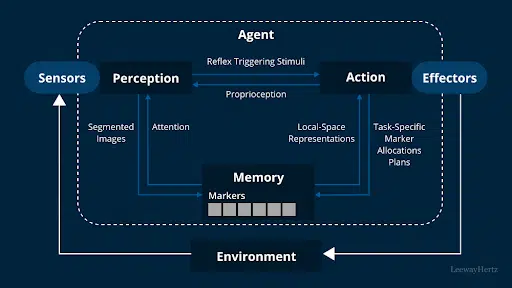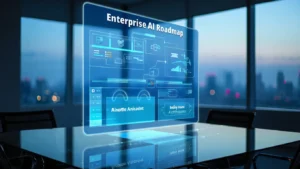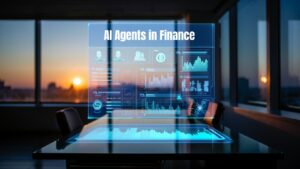Artificial intelligence is evolving from reactive chatbots to autonomous systems that can think and act independently. According to Gartner, over 40% of enterprises will experiment with autonomous AI agents by 2026. This growing shift underscores the rise of Agentic AI, the next step in intelligent automation.
What Is Agentic AI?
Agentic AI refers to AI systems designed with autonomy, capable of reasoning, planning multi-step tasks, adapting to changing contexts, and acting toward defined goals without constant human prompting. Traditional models respond to isolated instructions, but Agentic AI goes further. It exhibits goal-directed behavior, evaluating objectives, breaking them into sub-tasks, and executing them using available tools and data sources.
Agentic AI systems combine LLMs with planning frameworks, memory, and API integrations. So instead of just generating text, they can recall context, reason through next steps, connect to your databases or business tools, and then execute tasks refining their output based on feedback and results.
Key Capabilities of Agentic AI vs AI Agents
- Goal Orientation: Operates with defined outcomes rather than one-off commands, aligning AI behavior with business objectives.
- Autonomous Orchestration: Coordinates multiple systems and tools to complete sequential tasks end-to-end.
- Proactive Decision-Making: Evaluates context, adjusts strategy, and executes decisions based on real-time data.
- Continuous Learning: Adapts from prior outcomes and user feedback, improving accuracy and reliability over time.
Real-World Examples
- AutoGPT: Demonstrates autonomous task decomposition and self-directed execution using LLM reasoning.

- LangChain’s Autonomous Agents: Facilitate complex decision trees by integrating memory and external APIs.

LangChain lets developers ship production-grade autonomous agents - Enterprise Workflow Orchestration: Businesses are now experimenting with agentic frameworks to manage multi-step processes such as financial forecasting, logistics routing, or compliance documentation, reducing the need for manual oversight while maintaining control and traceability.

Enterprises are testing orchestration across data, apps, cloud, business processes, and hybrid workflows
Agentic AI marks a shift from responsive intelligence to proactive autonomy. For enterprises, it represents the next evolution of operational efficiency, where AI systems understand goals and actively work toward achieving them.
What Are AI Agents?
AI agents are practical implementations of agentic AI, built to perform specific tasks autonomously or semi-autonomously within defined contexts. They transform the reasoning power of agentic frameworks into actionable, task-driven systems that interact with data, users, and applications. In other words, they’re the “doers” that operationalize autonomous intelligence.
Where Agentic AI provides the reasoning layer—planning, prioritizing, and decision-making, AI agents serve as the execution layer. They connect with APIs, enterprise systems, and external data sources to carry out precise functions, report outcomes, and learn from feedback.
Suggested read: AI Readiness Checklist: Simple 9-Step Guide (2025)
How They Work
AI agents operate as modular building blocks powered by large language models and orchestration frameworks such as LangChain, AutoGPT, or CrewAI. They rely on pre-defined rules, contextual memory, and integrations with business applications (like CRM, ERP, or cloud services) to complete goals efficiently.
A single agent can handle one domain task, or multiple agents can collaborate under an agentic controller to solve broader problems.
Common AI Agent Categories
1. Task-Specific Agents
Perform well-defined, repeatable tasks within business workflows
Examples:
- Tier-1 customer support is handled end-to-end by AI agents. They verify policy details, retrieve claim status, process basic endorsements, and only escalate cases when human judgment is genuinely needed.
- Scheduling assistants that check availability across teams, propose the best slot, book rooms, send confirmations, and even follow up on attendance internally.
- DevOps or monitoring agents that detect anomalies in API latency or claims-core downtime, identify the root cause (e.g. failed integration or data pipeline), and trigger the exact remediation script to restore service.
2. Multi-Agent Systems
Composed of multiple specialized agents that communicate and collaborate to achieve complex objectives. Examples:
- AI-powered HR assistants automate onboarding workflows. They coordinate with payroll and compliance systems to verify documents and set up new employees efficiently.
- Financial analysis agents connect with forecasting and risk models. They assess portfolio performance and suggest precise adjustments to improve returns.
- Reasoning-driven RPA systems handle repetitive processes with adaptive intelligence. They adjust workflows automatically when business rules or data inputs change.
AI agents represent the execution arm of agentic AI, turning autonomous reasoning into measurable business outcomes. For enterprises, they connect intelligent decisioning with reliable task execution, enabling a new layer of AI-driven efficiency and collaboration across functions.
Agentic AI vs AI Agents – The Core Differences
While both Agentic AI and AI Agents operate within the same intelligent ecosystem, their purpose and autonomy levels differ significantly. The table below summarizes how each functions, scales, and delivers value in enterprise environments.
| Aspect | Agentic AI | AI Agents |
|---|---|---|
| Definition | Autonomous systems capable of reasoning, planning, and executing multi-step goals with minimal human input. | Task-oriented entities designed to execute specific functions within defined parameters. |
| Primary Role | The strategic brain — plans, orchestrates, and manages goals across multiple agents or tools. | The operational executor — performs discrete, well-defined tasks assigned by humans or agentic systems. |
| Autonomy Level | Highly capable of self-direction, planning, and adaptive reasoning. | Moderately dependent on predefined workflows, prompts, or agentic supervision. |
| Scope of Work | Multi-domain, long-horizon objectives (e.g., autonomous process orchestration, predictive business planning). | Narrow or domain-specific functions (e.g., ticket resolution, report generation, scheduling). |
| Learning & Adaptation | Continuously learns from outcomes, feedback, and changing environments to optimize future actions. | Limited to pattern-based improvement or supervised retraining. |
| Architecture | Combines LLMs with reasoning frameworks, memory, APIs, and multi-agent orchestration. | Built using LLM integrations and task-specific APIs or business apps. |
| Interaction Model | Can manage, create, and coordinate multiple agents to fulfill end-to-end goals. | Usually interacts with users or other systems to complete a task. |
| Examples | AutoGPT, LangGraph, CrewAI, enterprise AI orchestrators. | HR assistant, financial analysis agent, customer support automation. |
| Enterprise Use | Long-term process optimization, decision intelligence, and workflow orchestration. | Frontline execution, automating repetitive business tasks. |
In essence, Agentic AI acts as the orchestrator, providing autonomy, reasoning, and adaptability.
AI Agents serve as the executors, delivering targeted, repeatable outputs within the larger intelligent ecosystem. Combined, they form the foundation for scalable, enterprise-grade AI operations.
Suggested read: AI Compliance Monitoring: Benefits, Use Cases, Steps (2025)
Key Features of Agentic AI vs AI Agents
Both Agentic AI and AI Agents contribute to enterprise automation, but they do so through fundamentally different mechanisms. Agentic AI introduces strategic autonomy and orchestration, while AI Agents focus on executional precision within well-defined boundaries.
Agentic AI: Autonomy with Purpose
Agentic AI systems stand out for their ability to reason, plan, and act toward goals with minimal oversight. Their defining features include:
- Multi-Step Reasoning and Planning: Uses long-term objectives to design and adjust task sequences, rather than reacting to isolated prompts.
- Cross-Tool Integration: Connects with APIs, business platforms, and data layers to orchestrate complex workflows across departments or systems.
- Adaptive and Proactive Execution: Monitors progress, evaluates results, and refines actions dynamically based on contextual feedback.
- Memory and Context Awareness: Retains previous outcomes, improving decision-making consistency over time.
- Governance-Ready Design: Built with transparency and control features such as audit trails, explainability, and policy adherence — crucial for enterprise deployment.
AI Agents: Precision Through Specialization
AI Agents excel at performing repeatable, domain-specific tasks that drive measurable operational efficiency. Their distinguishing traits include:
- Task-Focused and Specialized: Designed for single or limited functions such as customer support, scheduling, or data validation.
- User-Facing Interaction: Engage directly with end users through chat interfaces, copilots, or embedded assistants.
- Domain-Bound Workflows: Operate within defined rules and datasets, ensuring predictable and reliable outputs.
- Rapid Deployment and Scalability: Easier to integrate into existing business applications with minimal infrastructure overhaul.
- Collaborative Potential: Can work alongside other agents or under an agentic controller to execute components of a larger workflow.
Agentic AI provides strategic intelligence, while AI Agents deliver operational efficiency. When combined, they enable organizations to design AI ecosystems that think, decide, and act, unifying strategic reasoning with scalable execution.
Business Use Cases of Agentic AI vs AI Agents
Agentic AI and AI Agents unlock enterprise value in distinct but complementary ways. Agentic AI systems excel in strategic reasoning and orchestration, while AI Agents deliver task-specific automation that improves speed, accuracy, and scale.
Below, we explore how both fit into real-world enterprise operations across RTS Labs’ core industries.
1. Finance and Banking
Agentic AI Use Case:
Financial institutions are adopting Agentic AI for autonomous risk management and predictive decisioning. These systems analyze historical data, monitor live market signals, and plan multi-step actions, such as adjusting portfolio exposure or flagging anomalies, without requiring human intervention.
AI Agent Use Case:
AI Agents support finance teams through automated credit scoring, fraud detection, and reconciliation workflows. For example, an AI-powered financial assistant can pull transaction data, verify anomalies, and report to compliance dashboards in seconds.
Impact:
Agentic AI provides long-horizon forecasting and strategy, while AI Agents handle high-frequency, precision-driven operations that sustain accuracy and regulatory compliance.
2. Supply Chain and Logistics
Agentic AI Use Case:
In logistics, Agentic AI functions as a central orchestration layer, evaluating delivery conditions, optimizing route sequences, and dynamically reallocating resources in real time. It reasons across multiple objectives: cost, capacity, and SLA performance.
AI Agent Use Case:
Task-based agents handle executional roles such as vehicle tracking, customer notifications, or route confirmation. For instance, a shipment-tracking agent interfaces with ERP and GPS systems to update delivery milestones automatically.
Impact:
Agentic AI enhances strategic coordination, while AI Agents ensure operational consistency, together, they enable fully autonomous logistics planning and monitoring.
3. Insurance and Risk Management
Agentic AI Use Case:
Agentic systems analyze claims trends, market shifts, and risk variables to plan and adapt underwriting strategies autonomously. They can also orchestrate multiple agents to verify claims, detect fraud, and recommend pricing adjustments.
AI Agent Use Case:
AI Agents manage frontline tasks, automating document processing, policy matching, and customer interactions. For example, an AI claims assistant can extract key details from forms, validate policy data, and escalate exceptions.
Impact:
Agentic AI acts as the strategic advisor, while AI Agents serve as the executional backbone, collectively reducing turnaround times and improving risk transparency.
4. Real Estate and Construction
Agentic AI Use Case:
Agentic AI can coordinate project scheduling, cost optimization, and resource planning by continuously learning from weather patterns, labor data, and material availability. It proactively recommends adjustments to minimize delays or budget overruns.
AI Agent Use Case:
AI Agents automate site-level and administrative tasks, such as tracking inspection reports, managing lease documents, or scheduling maintenance. A leasing agent, for instance, can answer tenant queries, verify credentials, and update CRM systems.
Impact:
Agentic AI drives strategic foresight and operational balance, while AI Agents enhance field-level responsiveness and accuracy.
5. Cross-Industry Applications (Data, Governance, and Customer Experience)
Agentic AI Use Case:
Acts as a governance layer, monitoring compliance rules, managing ethical frameworks, and enforcing audit trails across departments.
AI Agent Use Case:
Provides personalized experiences, from adaptive customer support bots to workflow copilots embedded in enterprise platforms.
Impact:
Together, they create closed-loop ecosystems where strategic intelligence (Agentic AI) guides execution (AI Agents), ensuring every interaction aligns with enterprise objectives and compliance standards.
In summary:
- Agentic AI introduces autonomous reasoning and orchestration across systems.
- AI Agents put that intelligence into action within existing workflows.
- Enterprises adopting both achieve strategic adaptability and executional precision.
- RTS Labs helps design, build, and scale this foundation through tailored AI consulting and development.
In a recent project with Suncoast Performance, a U.S.-based manufacturer of high-performance transmissions, we implemented a conversational AI assistant that unified scattered technical documents and FAQs. The solution enabled customers to receive instant, accurate answers while freeing skilled technicians from repetitive inquiries.

As a result, SunCoast improved response times, technician productivity, and customer satisfaction, showcasing how AI Agents operationalize intelligence while Agentic AI orchestrates reasoning and data retrieval to deliver measurable business impact.
Hybrid Approach: How Agentic AI and AI Agents Work Together
The most powerful enterprise AI architectures don’t treat Agentic AI and AI Agents as separate entities, they combine them. Agentic AI provides the autonomous reasoning engine, defining strategy and goals, while AI Agents execute the operational workflows that bring those strategies to life.
In this hybrid model, Agentic AI functions as the control layer—setting priorities, planning multi-step tasks, and orchestrating collaboration between agents. Meanwhile, AI Agents act as specialized executors, completing domain-specific actions and feeding performance data back to the agentic core for continuous optimization.
Example 1: Supply Chain Optimization
Agentic AI sets the strategy: It analyzes forecasts, identifies supply risks, and plans procurement and distribution targets for the quarter.
AI Agents execute the plan: Procurement agents secure vendors, logistics agents optimize delivery routes, and inventory agents track warehouse stock levels in real time.
Outcome: Strategic intelligence and operational execution stay synchronized, reducing downtime, minimizing excess inventory, and improving delivery accuracy.
Example 2: Financial Operations Automation
Agentic AI monitors operations: It evaluates expense data, compliance policies, and anomaly trends across multiple business units.
AI Agents act: Dedicated agents automatically flag irregular transactions, reconcile reports, and update dashboards for finance leaders.
Outcome: Continuous monitoring with near-zero manual oversight, ensuring compliance and faster financial decision-making.
Example 3: Customer Experience Management
Agentic AI defines engagement goals: It plans customer retention strategies based on behavioral analytics and predictive insights.
AI Agents implement: Service agents handle customer inquiries, marketing agents personalize campaigns, and CRM agents sync data across channels.
Outcome: Every customer interaction aligns with strategic intent, increasing satisfaction and loyalty through coordinated automation.
RTS Labs’ Role in the Hybrid Model
We at RTS Labs design enterprise-grade AI architectures where Agentic AI orchestrates goals and AI Agents deliver measurable results. Through a combination of AI consulting, custom development, and integration services, RTS Labs helps organizations:
- Build secure, compliant frameworks for autonomous reasoning and decision-making.
- Deploy AI agents across finance, logistics, and customer service operations.
- Enable real-time orchestration between agentic control layers and executional agents.
By blending strategic autonomy with operational precision, RTS Labs empowers enterprises to turn AI into a self-optimizing ecosystem, one that plans intelligently, acts efficiently, and scales responsibly.
Challenges & Risks of Agentic AI and AI Agents
As enterprises scale from AI experimentation to full autonomy, the challenges of managing Agentic AI and AI Agents become more pronounced. While these systems promise efficiency and adaptability, they also introduce new layers of technical, operational, and ethical complexity that demand careful oversight.
1. Data Quality and Interoperability
Agentic systems rely on continuous access to accurate, integrated, and up-to-date data. Fragmented data pipelines, legacy systems, or inconsistent formats can break reasoning chains and degrade decision quality. Poor interoperability between AI agents and enterprise platforms further amplifies these risks, limiting coordination across departments.
2. Over-Autonomy Risks
Autonomous agents that act beyond intended boundaries can lead to unintended actions or cascading errors. For instance, triggering redundant workflows, misallocating resources, or making misaligned recommendations. Without proper controls, an overly independent AI system can deviate from business intent, creating operational or reputational risks.
3. Complexity of Multi-Agent Environments
As organizations deploy multiple agents for different domains, managing communication, coordination, and priority alignment becomes increasingly complex. Each agent may have its own task model, learning parameters, and data source, requiring a central governance layer to prevent conflicts or inefficiencies.
4. Compliance, Governance, and Ethics
Agentic and autonomous systems raise important questions around accountability, auditability, and ethical AI usage. Enterprises must ensure transparency in decision-making processes, maintain human oversight, and adhere to evolving global standards such as GDPR, HIPAA, and emerging AI governance regulations.
Our Role: Building Guardrails for Responsible AI
At RTS Labs, we help organizations establish robust governance frameworks that ensure autonomy never comes at the expense of safety or compliance. Through a blend of data quality engineering, AI model monitoring, and human-in-the-loop design, we enable:
- Transparent decisioning with clear audit trails
- Configurable autonomy levels that balance efficiency with control
- Secure interoperability between multi-agent systems and enterprise applications
By embedding guardrails and governance into every stage of AI development, we ensure agentic and autonomous systems operate reliably, ethically, and in alignment with business objectives.
Struggling with these Agentic AI challenges?
- Data gaps and system silos breaking reasoning chains.
- Overly independent AI agents acting beyond business intent.
- Complex multi-agent setups causing coordination issues.
- Governance and compliance gaps risking audit and ethical oversight.
RTS Labs helps you take control of AI autonomy, with built-in governance, transparent decisioning, and secure system integration.
Contact us now to build AI that’s powerful, responsible, and aligned with your goals.
Future Trends in Agentic AI and AI Agents
The evolution of enterprise AI is shifting from isolated automation toward coordinated, self-optimizing ecosystems. As technologies mature, Agentic AI and AI Agents will increasingly converge, creating systems that not only execute tasks but also plan, reason, and adapt across dynamic business environments.
Rise of Multi-Agent Systems
Organizations are moving toward multi-agent architectures where multiple AI agents collaborate under an agentic controller. These systems can coordinate complex enterprise tasks, like optimizing supply networks, adjusting pricing dynamically, or managing predictive maintenance, without continuous human direction.
AI Copilots with Generative Reasoning
The next generation of copilots will go beyond conversational assistance. By merging generative reasoning with agentic execution, copilots will be able to plan multi-step tasks, interact with enterprise data systems, and take proactive actions aligned with business goals.
LLMs for Decision Intelligence
Large Language Models are evolving into engines for decision intelligence, using contextual understanding and historical data to drive predictive workflows. Combined with agentic orchestration, they will power autonomous decision-making systems that can adapt to market fluctuations, customer behaviors, and operational constraints.
Integration with Core Enterprise Systems
Agentic AI and AI Agents will increasingly integrate with ERP, CRM, SCM, and IoT ecosystems, enabling real-time coordination between strategy and execution. Imagine an ERP that not only tracks inventory but autonomously adjusts procurement or a CRM that dynamically reassigns sales leads based on predictive insights.
The Expanding Human Role
Contrary to fears of replacement, the human role will grow, not shrink. As AI systems assume greater autonomy, humans will become essential in governance, oversight, ethical guardrails, and strategic direction. Instead of displacing people, Agentic AI and AI Agents will augment human capability, helping leaders make faster, more informed, and ethically grounded decisions.
In short:
- Enterprise AI is shifting toward self-optimizing, adaptive ecosystems.
- Multi-agent systems will coordinate complex business operations autonomously.
- AI copilots will plan and act, not just assist.
- LLMs will drive predictive, data-informed decisions.
- Integration with core enterprise systems will tighten strategy–execution alignment.
- Humans will guide and govern AI, ensuring ethical and strategic balance.
Agentic AI vs AI Agents: How RTS Labs Helps Organizations Use Both
Agentic AI provides the autonomous intelligence layer, while AI Agents operationalize it. At RTS Labs, we architect agentic systems, design domain-specific agents, and ensure secure, compliant deployment at scale, helping enterprises unlock practical, measurable business value from next-generation AI.
Want to explore what this could look like for your use case? Book a short discovery call with our AI strategy team.
FAQs
1. Are Agentic AI systems safe to deploy without constant human supervision?
Yes, when designed with guardrails. Agentic AI requires governance layers such as autonomy limits, approval policies, audit trails, and intervention triggers to ensure safe operation.
2. Can AI Agents operate independently without an Agentic AI layer?
They can, but they will be siloed. AI Agents excel at executing tasks. Without an agentic orchestration layer, they cannot coordinate with other agents, adapt priorities, or optimize for enterprise-wide goals.
3. What industries see the fastest ROI from Agentic and Agent deployments?
Insurance, logistics, commercial banking, and manufacturing, where repetitive workflows and structured data accelerate automation outcomes.
4. Can we start small or do we need to replatform our existing stack?
You can start small. RTS Labs typically begins with one or two domain agents, validates outcomes, then scales into a hybrid agentic architecture.






